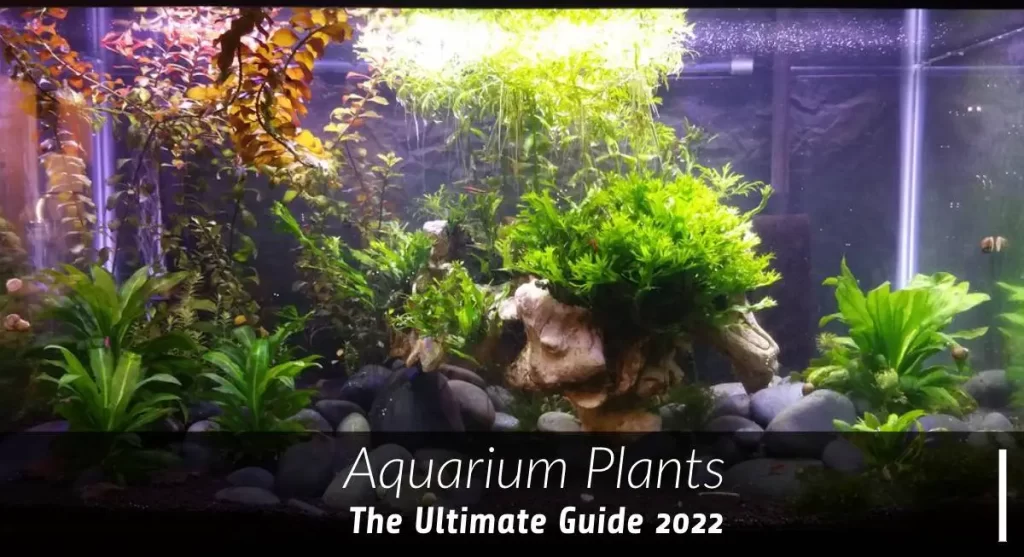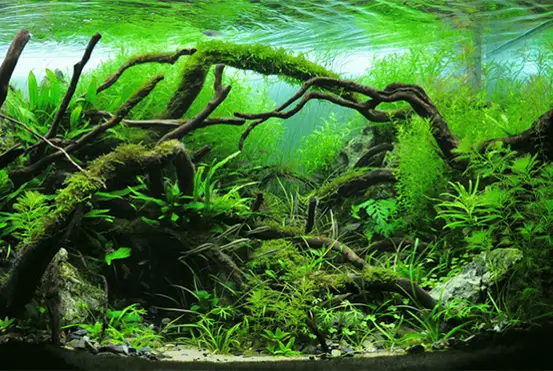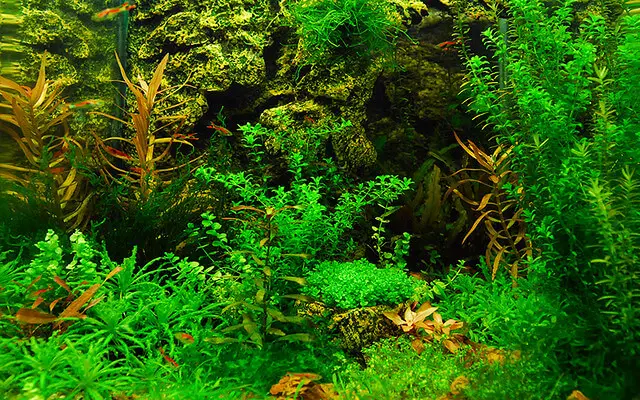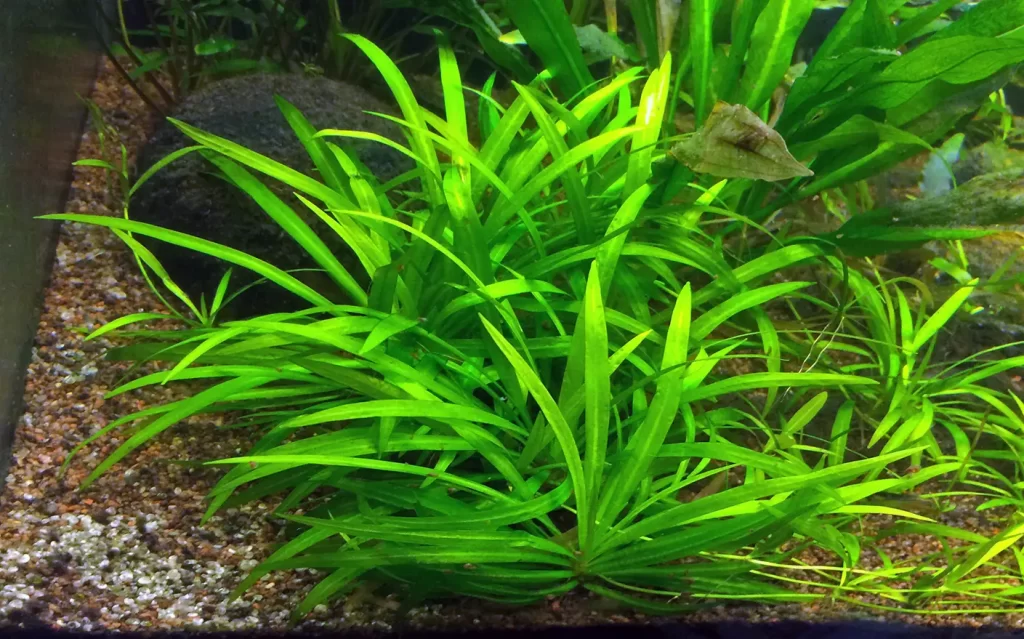Aquarium plants are a great way to improve the appearance of your tank, and they also provide a number of benefits for your fish. Not all plants are created equal, however, so it is important to choose the right ones for your aquarium. In this article, we will discuss some of the best aquarium plants available and explain why you should consider adding them to your tank.
When it comes to aquarium plants, there are a lot of different opinions on what the best ones are. Some people swear by Moneywort, while others prefer Hornwort. Rotala Rotundifolia is another popular choice, as is Pygmy Chain Sword. Then there are those who love Hygrophilia Polysperma, Cryptocoryne Wendttii, or Anubia Nana. The options go on and on! In this blog post, we will take a look at some of the most popular aquarium plants and discuss what makes them so great.
| Image | Plants for aquarium | Link |
 |
Java Moss | |
 |
Amazon Sword | |
 |
Hornwort | |
 |
Java Fern | |
 |
Anubias Petite | |
 |
Ludwigia Repens | |
 |
Anacharis | |
 |
Brazilian Pennywort | |
 |
Christmas Moss | |
 |
Cryptocoryne Wendtii |
What Are The Best Aquarium Plants?
There are a lot of different opinions on what the best aquarium plants are, but there are a few that stand out above the rest. Moneywort, Hornwort, Rotala Rotundifolia, and Pygmy Chain Sword are all great choices for aquariums. They each have their own unique benefits that make them ideal for fish tanks.
You might also be interested in 9 Best Low Light Aquarium Plants | Benefits of Aquarium Plants.
The Best Carpet (Foreground) Plants for Beginners
If you are new to the world of aquarium plants, it is best to start with something that is easy to care for. Java Moss, Lilaeopsis, Dwarf Baby Tears are all great choices for beginners. They are relatively low maintenance and can tolerate a wide range of water conditions.
These three plants are also great options if you have limited space in your aquarium.
Java Moss
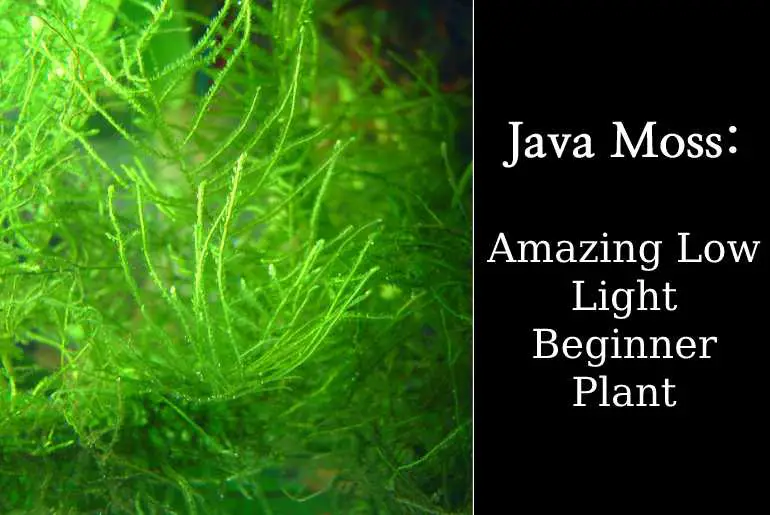
Java moss is a popular choice for aquariums because it is very easy to care for. It can tolerate a wide range of water conditions and does not require much light to grow. Java moss is also a great plant for hiding equipment in your aquarium.
| Difficulty | Easy (some problems might occur, but it is easy to care for) |
| Size of Plant | 4″+ or 10 cm |
| Propagation | Cuttings |
| Type of Fertilizer | Liquid |
| Speed of growth | Moderate |
| Temperature of Water | 59°F to 86°F (15°C to 30°C) |
| pH of Water | 5.0 to 8.0 or higher |
| Hardness of Water | 3 to 12 dKH |
| Placement in aquarium | Floating or attached |
| Natural Habitat | Southeast Asia |
| Aquascaping | Foreground or attached |
| Availability of Java Moss | Very common |
Lilaeopsis/ Brazilian Micro Swords
Lilaeopsis is another great option for beginners. It is an attractive plant that grows quickly and does not require much maintenance. Lilaeopsis can be planted in the foreground or midground of your aquarium and will add a splash of color to your tank.
| Difficulty | Moderate soft to moderately hard |
| Size of Plant | 4″+ or 10 cm |
| Propagation | Cuttings |
| Type of Fertilizer | CO2 |
| Speed of growth | Moderate |
| Temperature of Water | 70 to 83°F |
| pH of Water | 6.8 to 7.5 |
| Hardness of Water | soft to moderately hard |
| Placement in aquarium | Floating or attached |
| Aquascaping | Foreground or attached |
| Availability | Very common |
Dwarf Baby Tears
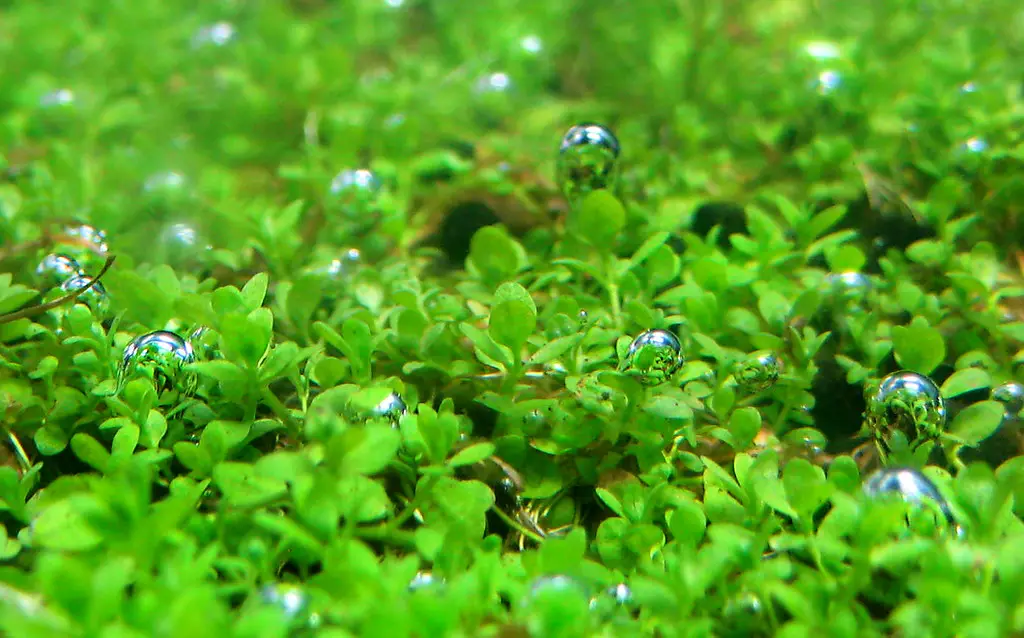
Dwarf baby tears are perfect for smaller tanks or nano tanks. They are slow-growing plants that do not require much light or fertilizer. Dwarf baby tears are also relatively easy to care for, making them a great choice for beginners.
| Difficulty | Moderate |
| Size of Plant | 24” |
| Type of Fertilizer | CO2 |
| Speed of growth | Moderate |
| Temperature of Water | 68 to 82°F |
| pH of Water | 5.0-7.5 |
| Hardness of Water | 0-10 KH |
| Placement in aquarium | Floating or attached |
| Aquascaping | Foreground or attached |
| Availability | Very common |
The Best Plants for the Middle or Background of Your Tank
If you are looking for plants to add to the middle or background of your aquarium, there are a few great options. Anubias, Bucephalandra, and Cryptocoryne are all good choices.
Water Wisteria

Wisteria is a beautiful plant that can add a lot of color to your aquarium. It is relatively easy to care for and does not require much light. Wisteria can be planted in the foreground, midground, or background of your aquarium.
It’s a freshwater plant that’s known for being one of the toughest aquarium plants.
These lovely plants are well-known for a variety of characteristics, the first of which is their leaves. They feature lovely bright green leaves with serrated borders oval and lace-like shapes that can grow from 0.5 to 1.5 inches long.
Water wisteria is particularly well-known for another remarkable trait. They can adapt to their surroundings and change or alter their morphology as a result.
So, if you notice them acting a little different than usual, it’s most likely because of the tank.
| Difficulty | Difficult |
| Size of Plant | 20 inches |
| Type of Fertilizer | Low |
| Speed of growth | Moderate to medium |
| Temperature of Water | 68 °F to 82 °F |
| pH of Water | 6.5 to 7.5 |
| Hardness of Water | 2 to 8 dKH |
| Placement in aquarium | foreground, midground, or background |
| CO2 | 10 ml to 40 ml per liter |
Amazon Sword
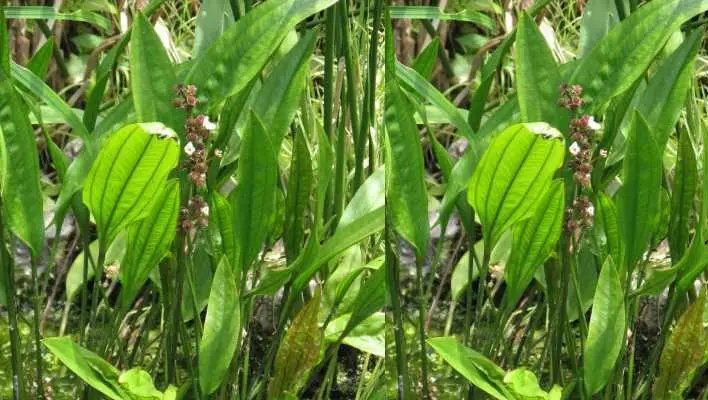
Beginners will enjoy this Amazon Swords Plant because it requires no maintenance and can thrive in a variety of tanks (low tech to high tech tanks). Amazon Sword is also an excellent background plant.
This plant can be eye-catching when planted alone, with its lush green foliage standing out against the dark background. They can generate a lush green forest-like look when planted alongside others of their species.
Amazon sword is a popular plant for aquariums. It is easy to care for and can tolerate a wide range of water conditions. Amazon sword is also a great plant for hiding equipment in your aquarium.
Buy amazon sword here.
| Difficulty | Easy |
| Size of Plant | Up to 30 cm to 50 cm |
| Type of Fertilizer | Low |
| Speed of growth | Moderate to medium |
| Temperature of Water | 22 to 27 degrees Celsius |
| pH of Water | 6.0 pH to 8.0 pH |
| Hardness of Water | 2 GH to 12 GH |
| Placement in aquarium | Background |
| CO2 | Low |
| Propagation | Through adventitious plantlets or splitting at the crown |
Anubias
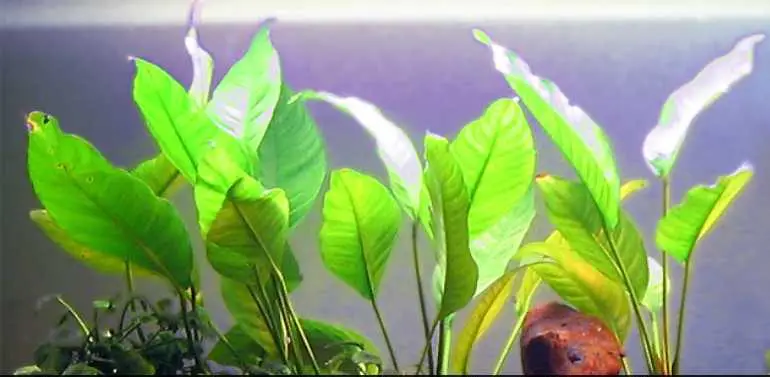
Anubias are quite popular. These are my favorites too. This is because the plant is so undemanding yet highly attractive. It has green leaves and a strong root structure making it instantly noticeable. These plants are quite versatile too. They come from tropical Central and West Africa.
Buy Anubias here.
| Difficulty | Easy |
| Size of Plant | It depends on the type of Anubias
from 5 cm to 100 cm (2 inches to 40 inches) |
| Type of Fertilizer | Low |
| Speed of growth | slow |
| Temperature of Water | 22 to 28 degrees Celsius (72 to 82 degrees Fahrenheit) |
| pH of Water | 6.0 pH to 8.0 pH |
| Hardness of Water | 2 to 15 |
| Placement in aquarium | Mostly foreground or midground and rarely background |
| CO2 | Low |
| Propagation | Cutting the Rhizome
Anubias Plantlets |
Java Fern
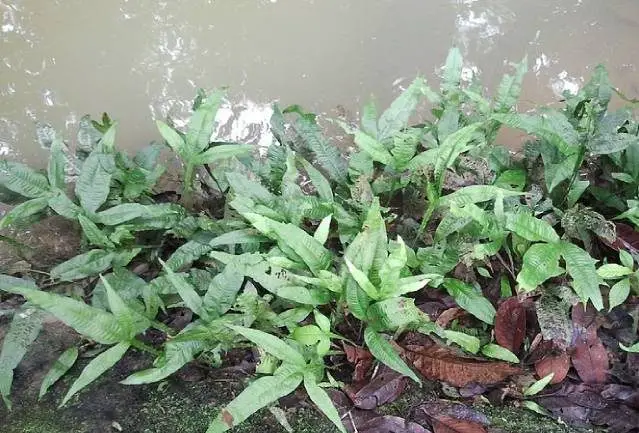
Java Fern is a slow-growing plant that is perfect for your aquarium after it grows well. It attaches itself to rocks and woods which makes it foreground or background plant.
The Java Fern exists in freshwater rivers in Thailand, Malaysia, India, and China. Moreover. They have a thick twig-like structure that needs substrate. It is perfect for cichlid aquariums with driftwoods and rocks.
You don’t have to worry about your fish eating Java Fern too. So, it has a high chance of survival.
Buy Java Fern here.
| Difficulty | Easy |
| Size of Plant | 7 to 8” |
| Type of Fertilizer | Low |
| Speed of growth | slow |
| Temperature of Water | 68-82° F |
| pH of Water | 6.0 pH to 7.5 pH |
| Hardness of Water | 3 to 8 KH |
| Placement in aquarium | Mostly foreground or background |
| CO2 | Low |
African Water Fern
As its name suggests, it is from the African river beds. Moreover, it attaches itself to rocks and wood. Thus, being fully submerged or partially.
It grows quite fast in the warm freshwaters. The common mistake here is planting the roots on the substrate. This will ultimately rot the plants, and they die. You can attach them to rock with elastic bands and remove them once they get attached. This will take you a week or two.
It is easy to grow but is a slow-growing plant.
| Difficulty | Easy |
| Size of Plant | 20” |
| Type of Fertilizer | Low |
| Speed of growth | slow |
| Temperature of Water | 74 to 84°F |
| pH of Water | 6.0 pH to 8.5 pH |
| Hardness of Water | 5 to 15 KH |
| Placement in aquarium | Mostly foreground or background |
| CO2 | Low |
Cryptocoryne Beckettii
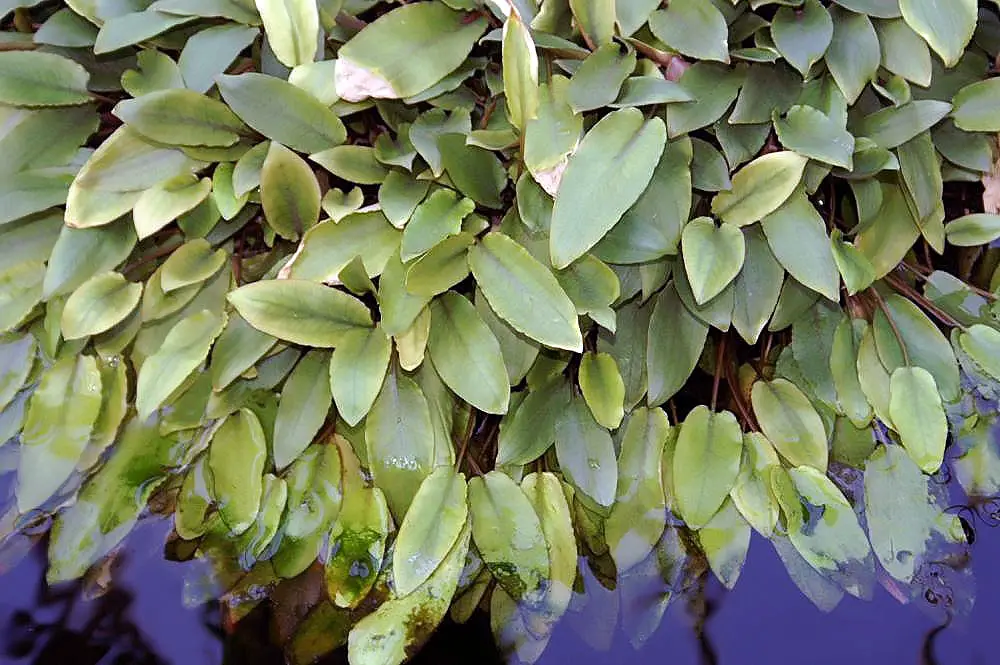
These plants are quite hardy. You might have heard about the water trumpet. It is a foreground plant that can also suit best in mid-ground as it can reach up to 6 inches too.
These plants have slow growth and can take several weeks to hold on to the roots firmly. Moreover, soil-based substrate or aquarium gravel will work fine for these plants. I will suggest you use some plant fertilizer before you put it into the water if you buy it in a pot.
Buy Cryptocoryne Beckettii here.
| Difficulty | Easy |
| Size of Plant | 4-6” |
| Type of Fertilizer | medium |
| Speed of growth | slow |
| Temperature of Water | 72 to 82°F |
| pH of Water | 5.5 pH to 8.0 pH |
| Hardness of Water | 1 to 20 KH |
| Placement in aquarium | Mostly foreground or background |
| CO2 | Low |
Tiger Lotus

I personally feel that some color to the aquarium will smooth out the boredom. You should definitely look for the good ones while buying them, though.
Make sure you look for the bulb of the lotus and press it gently to inspect if it is squashy or mushy. If it is, then stay away from such plants as they are about to rot or have died.
When planting it, keep the bulb showing out in the aquarium so that it can grow out into a beautiful red plant.
| Difficulty | Easy to moderate |
| Size of Plant | 45cm |
| Type of Fertilizer | medium |
| Speed of growth | medium |
| Temperature of Water | 72 to 82°F |
| pH of Water | 5.0 pH to 8.0 pH |
| Hardness of Water | 2 to 15 dGH |
| Placement in aquarium | midground |
| CO2 | Low |
Christmas Moss
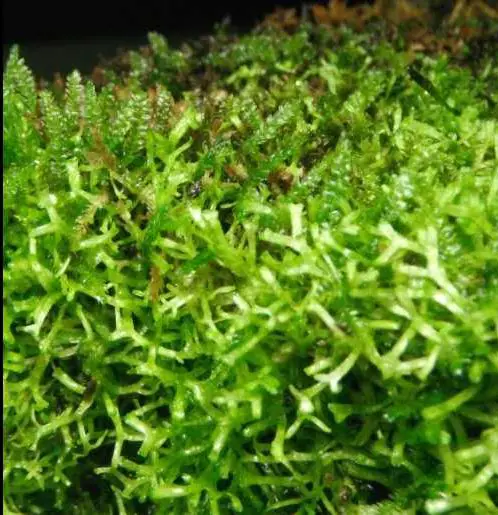
Christmas moss is a southeast Asian plant. It is primarily found in India, Japan, and a few other tropical or semi-tropical nations. Although it is not a plant that grows in water, it does require moisture to thrive.
As a result, you could come upon it on rocks near rivers and lakes. However, this isn’t the only area you’ll discover Christmas Moss. It also grows near trees and on rocks in woodlands. It thrives in areas with plenty of moisture and something to adhere itself on.
| Name: | Christmas moss, Xmas moss, Vesicularia montagnei |
| Size: | 3 inches (4 cm) tall |
| Care level: | Moderate |
| The temperature of water: | 72° F to 82° F (22° C to 28° C) |
| the pH of water: | Highly adaptable (5.0 to 7.5) |
| The hardness of water: | 5 to 15 dKH |
| Position in the aquarium: | Accent plant or Foreground |
| Propagation: | Creeping and clippings |
| Fertilizer: | Liquid |
| Growth of plant: | Moderate |
| Origin and natural habitat: | Southeast Asia |
Additional Plant Choices You Can Make
Here are additional plant choices that you can make to keep in your aquarium:
Moneywort
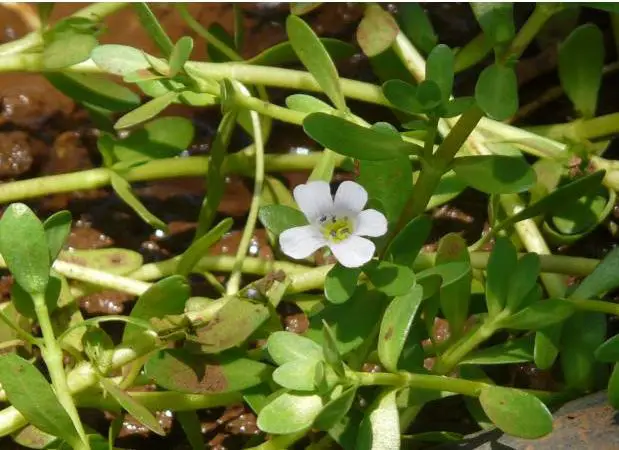
Moneywort is a great plant for aquariums because it helps to oxygenate the water. This is beneficial for both your fish and your plants. Moneywort also provides a hiding place for fish, which can help reduce stress levels.
Moneywort (Bunium persicum) is a creeping, groundcover plant that is native to the Mediterranean region. It is commonly grown as an aquarium plant, due to its ability to tolerate both low and high light levels.
Moneywort has small, oval-shaped leaves that are arranged in pairs along the stem. Additionally, the leaves are dark green in color and have a glossy sheen. Moneywort will bloom in late summer or early fall, producing small, white flowers.
The flowers are borne on slender stalks that rise above the foliage. Moneywort is an easy-to-care-for plant that makes an excellent addition to any aquarium.
Buy Moneywort here.
Hornwort
Hornwort is another excellent plant for aquariums. It is known for its ability to absorb nutrients from the water, which can help to keep your tank clean. Hornwort is also a fast-growing plant, so it can quickly fill in any empty spaces in your aquarium.
Hornwort is a common aquarium plant that gets its name from its pointed, horn-like leaves. Moreover, Hornwort can also be a nuisance in your aquarium because it produces a lot of debris that can clog your filter.
Hornwort is native to North America and can be found in ponds, lakes, and streams. Hornwort can also be found in Europe, Asia, and Africa. It is an important food source for fish and other aquatic creatures.
Likewise, it can also be used as a natural filter in many aquaculture systems. Hornwort is easy to care for and does not require much maintenance. Hornwort can be propagated by cutting the plant into small pieces and replanting them in the substrate. Similarly, hornwort can also reproduce by producing small spores that are released into the water column.
Buy Honeywort here.
Rotala Rotundifolia

Buy Rotala Rotundifolia here.
Pygmy Chain Sword

Pygmy Chain Sword is a compact plant that is perfect for small aquariums. It grows slowly and stays relatively small, making it a good choice for tanks with limited space. Pygmy Chain Sword is also known for its ability to absorb nutrients from the water, which can help to keep your tank clean.
Hygrophilia Polysperma

Buy Hygrophilia Polysperma here.
Cryptocoryne Wendttii
Cryptocoryne Wendttii is a beautiful plant that adds color and interest to an aquarium. It grows slowly and can reach up to two feet in height. Cryptocoryne Wendttii is also a great plant for oxygenating the water.
Buy Cryptocoryne Wendttii here.
How To Choose The Right Aquarium Plants?
When it comes to choosing the right plants for your aquarium, there are a few things you need to consider. Water conditions, temperature, substrate, and lighting all play a role in how well your plants will grow.
Water Conditions
The first thing you need to consider when choosing aquarium plants is the water conditions in your tank. This includes the pH level, hardness, and temperature of the water. You will need to choose plants that are compatible with these conditions.
Temperature
The temperature of the water is also important when choosing aquarium plants. Some plants require warmer temperatures than others. Make sure you research the ideal temperature for each plant before adding it to your tank.
Substrate
The type of substrate you use can also affect how well your plants will grow. Some plants need a sandy substrate, while others prefer a gravel substrate. Choose a substrate that is compatible with the plants you want to add to your tank.
For gravel substrates, I suggest:
For sand substrates, I suggest:
- Carib Sea ACS05820 Super Natural Moonlight Sand for Aquarium, 5-Pound
- Carib Sea ACS05840 Super Naturals Crystal River Sand for Aquarium, 5-Pound
Lighting
Proper lighting is essential for aquarium plants. Plants need light to photosynthesize and produce food. Without adequate lighting, your plants will not be able to grow properly. Make sure you choose a light that is bright enough for the plants you want to add to your tank.
NICREW Light is one of the best for the planted aquariums.
Aquarium Plants Need Food Too
In addition to light, water, and temperature, aquarium plants also need food to survive. You can provide nutrients for your plants in two ways: liquid fertilizer and tablet fertilizer.
Liquid Fertilizer
Liquid fertilizer is a great way to provide nutrients for your plants. You can add it to the water or directly to the soil. Liquid fertilizer is easy to use and can be found at most pet stores.
Tablet Fertilizer
Tablet fertilizer is another great option for feeding your plants. Moreover, tablet fertilizer can be added to the soil or placed in the water. Tablet fertilizer releases slowly over time, so it lasts longer than liquid fertilizer.
Seachem Flourish Tabs Growth Supplement – Aquatic Plant Stimulant 40 ct is a good option.
Uneaten Fish/ Food Waste
Another source of nutrients for aquarium plants is uneaten fish food and waste. As your fish eat, they excrete waste that contains nutrients that your plants can use. This waste can be collected and used as fertilizer for your plants.
By following these tips, you can choose the right plants for your aquarium and create a beautiful underwater garden. With a little care and attention, your plants will thrive and add color and interest to your tank.
What Problems Will You Have To Face When You Keep Aquarium Plants?
The most common issue that aquarium plant keepers will notice is algae in the tank. It will create a mess and invite diseases in the aquarium if you do not clean it properly. For this, you can keep shrimps and snails that will eat out the algae. There are also some freshwater aquarium algae eaters that might help you in this regard.
Here are the 30 best algae eaters for freshwater aquariums and how you can get rid of algae in a fish tank naturally?
You might also need aquarium fertilizers and learn how to propagate the plant properly. Or else, you might just spend your money and not get any results for it. So, be careful with the plants. Make sure you put the aquarium plants in tanks that match the water conditions and also keep fishes that match the same level of water quality.
How To Clean The Planted Aquarium?
You can clean the planted aquarium by using the following procedure. It is quite essential to clean the planted tank so that you can clear the algae and get the tank cycle going.
- Begin by turning off both your filter and your heater.
- If there are any floating plants, remove them.
- Set up a separate tank for your occupants.
- Remove the centerpiece as well as the filter and thoroughly clean it.
- You may clean the walls of your nano tank with a blade or a sponge.
- Trim away any excess growth, then vacuum the water and refill it.
Conclusion
Aquarium plants are a great way to add color and interest to your tank. When choosing plants for your aquarium, make sure you consider the water conditions, temperature, substrate, and lighting. Also, be sure to provide adequate nutrients for your plants. With proper care and attention, your aquarium plants will thrive.
Do you have any tips for choosing the right aquarium plants? Let us know in the comments below!
If you’re looking for more information on aquarium plants, check out our article on the best beginner aquarium plants. Thanks for reading!

